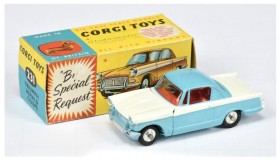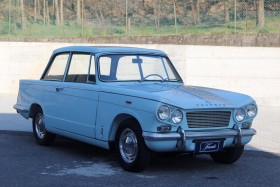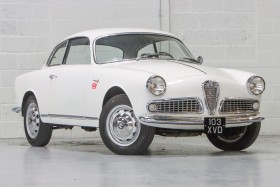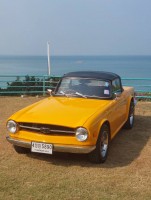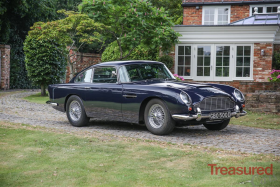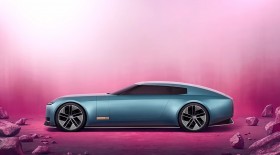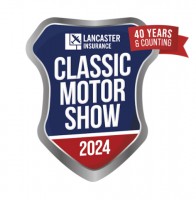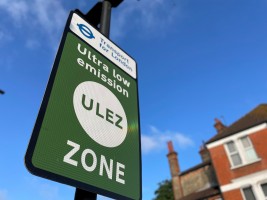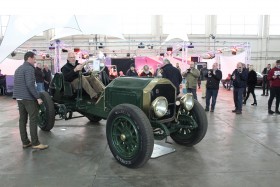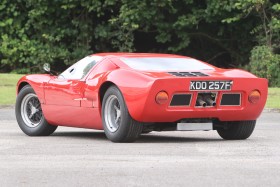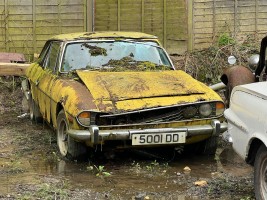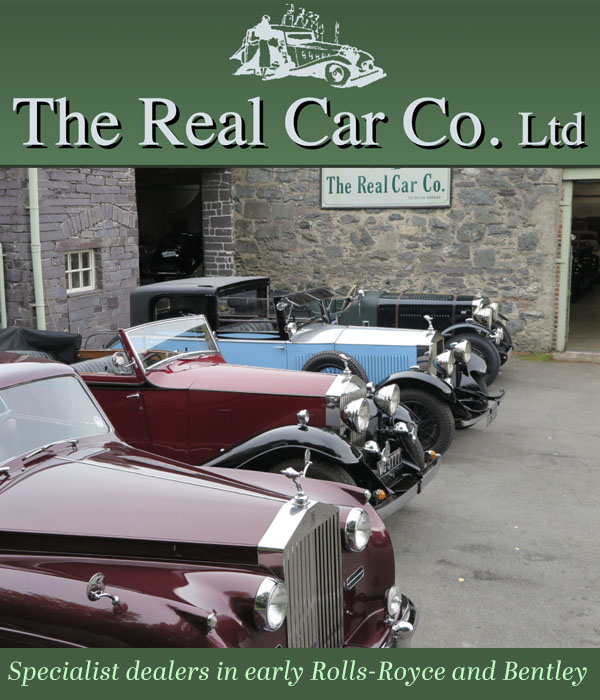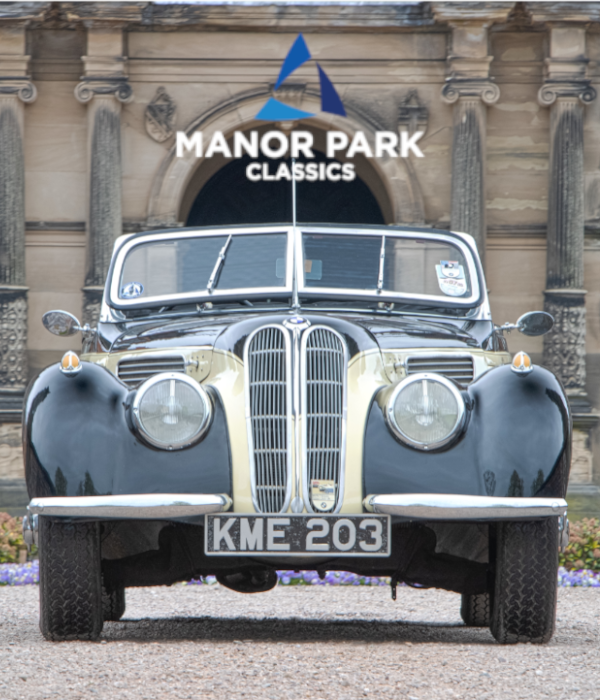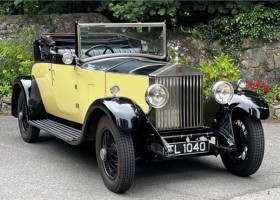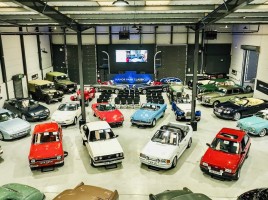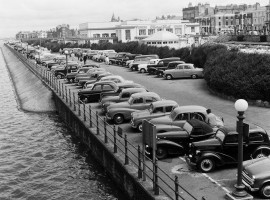accidental triumphs the herald vitesse spitfire and gt6
Inspired by the Herald coupe seen at the Classic Motor Show 2021
By: Terry Burgess Tue, 16 Nov 2021
Features
Another car which caught my eye at the show was the lovely two-tone Coupe shown above. One of my favourite Corgi models as a child was the miniature of this car, as pictured below. The Herald appeared in 1959 and lasted until 1971. From that basic design came the 6-cylinder 1596cc Vitesse 6 and the 4-cylinder 1147cc Spitfire 4, in 1962. The Vitesse would mature into the Vitesse 2-litre and the Spitfire would be joined by a similarly powered fastback version called the GT6, both in 1966. The Vitesse had gone by 1971, like the Herald, but the GT6 continued until 1973 and the Spitfire would soldier on until 1980, when the Standard-Triumph factory at Canley was closed.
The Herald became a common sight on the UK's roads during the 60s and 70s, but it was a car which easily might never have been.
In the mid to late 1950s, the Triumph name was used only for the TR2 and TR3 sports cars. Triumph had been absorbed by the Standard Motor Company after WWII, having been moribund at the outbreak of the war. The post-war Triumph Renown, Mayflower and 1800 Roadster models were designed and engineered by Standard and had nothing to do with pre-war Triumph models. These worthy, but rather dated models had all gone by the early 1950s. The Standard 8, 10, Pennant, Ensign and Vanguard models were produced to satisfy the demand for saloon and estate cars thereafter.
As the turn of the decade approached it was obvious that the smaller Standard models, launched in 1954, although of unitary construction and having modern OHV engines and 4-speed gearboxes, were becoming quite dated in appearance. Standard-Triumph approached their body contractor, Fisher & Ludlow, in preparation for a new monocoque design to carry the company into the 1960s.
Fisher & Ludlow, however, had been taken over by the British Motor Corporation in 1953 and declined to enter into negotiations for the provision of a new bodyshell. To say the least, this put Standard-Triumph in an invidious position! It did not affect existing contracts, but how were they to proceed with a new small car design? There was no alternative supplier with available capacity.
As a matter of expediency, it was decided that the new model should be built on a separate chassis frame, with the floor pan and upper bodywork built up of quite a number of relatively small pressings bolted together. This method of construction would enable saloon, estate, van and convertible models to be built very simply by the substitution of a few upper panels at a fairly late stage of construction. To facilitate this solution the company purchased a number of suitably-sized manufacturers of steel pressings in order to guarantee supply.

This was a remarkable strategy for the unitary or monocoque method of car body construction had only become widespread in the previous few years. The separate chassis frame was now generally reserved for the more traditional prestige makes, such as Armstrong-Siddeley, Daimler, Rover, and Rolls-Royce or for sports cars such as the Austin-Healey, Morgan and MG. Building a small car on a separate frame might easily be seen as old-fashioned or retrograde.
Amazingly, the new car was not seen in that light at all, due to some very advanced features which Standard-Triumph very cleverly built in to the design, some of which would have been far less easy to provide had unitary construction been used. The chassis itself was of a semi-backbone design rather than the traditional ladder-type used on pre-war cars, allowing dropped footwells and a low build. Independent suspension was provided to both the front and rear wheels. The chassis made it much easier to mount the differential without excessive noise transmission to the body. Although IRS was not unusual on rear-engined cars, it certainly was on a front engined rear-wheel-drive model and was seen as progressive, although this feature was provided by the swing-axle method with a transverse leaf spring, which had certain limitations, as would become more evident with the models later developed from the Herald. It also had rack and pinion steering; nothing new - the Morris Minor had that, but it was arranged such that the Herald had a remarkably small turning circle of only 25 feet! The styling, by Michelotti, certainly was modern, with sharp, striking lines, slim pillars and a large glass area. It also had a one-piece front end which tilted forwards to reveal the engine, front suspension and steering; the mechanic's dream! Much was also made of the ease of accident repair due to the bolted-together construction.
Although the first Herald, announced in 1959, had only the 948cc engine carried over from the Standard 10 and was somewhat austerely trimmed, it was successful. Twin SU carburettors were available as an optional extra by 1960, giving a useful boost to performance, and these were fitted as standard to the Convertible and the attractive, if somewhat impractical, Coupe version. Originally intended as a Standard, the new car was called Triumph, the Standard brand having rather negative connotations by 1959 as denoting 'bog-standard' or very basic. It would be in disuse after 1963.
In 1961 the most obvious deficiencies of the early Herald were addressed with the introduction of the 1200 model with an 1147cc 39bhp engine. The original car would continue as the Herald 'S'. Additionally offered were spacious Estate and Courier Van versions. All passenger models, with the exception of the 'S', were fitted with white rubber-faced bumpers and had an attractive, if sparsely instrumented, real walnut facia. The 1147cc unit gave a useful increase in torque. The Herald now justifiably occupied a unique position in the market as a rather sporty and luxurious small car of advanced design. It was a cut above other small cars of the day, with features such as an adjustable steering column, seats adjustable for tilt and a reserve fuel tap adding to the sense of economical privilege. The 12/50 sunroof model with 51bhp and disc front brakes came in 1963, as an additional model, with increased exclusivity.

Meanwhile, in 1962, the Spitfire 4 and Vitesse 6 models were introduced. The Spitfire used a shortened and abbreviated version of the Herald chassis with a completely new and fully welded body tub. This had also been styled by Michelotti and looked great. The Vitesse was essentially a Herald fitted with a 1596cc 70bhp version of the Vanguard Six 1998cc unit. The front end was restyled with slanted quad headlamps. It was the cheapest six-cylinder car on the market and gave smooth 90mph performance. The 2-litre version from 1966 had 95bhp and was good for around 100mph. The limitations of the swing-axle rear end were now becoming very obvious and something had to be done! From 1968, the MK2 Vitesse had modified rear suspension with a lower link and Rotoflex couplings in the driveshafts. This was a reasonably cheap and simple way of creating a semi-trailing arm IRS and improved the stability of the the Vitesse (and the GT6 MK2) enormously. However the Rotoflex couplings were prone to wind-up and disintegration, so they weren't ideal. Following the end of Vitesse and Herald production in 1971, the GT6 MK3 received the 'Swing-spring' suspension, also fitted to the Spitfires MK4 and 1500. This was a return to the cheaper and simpler swing axles, but with a pivoting spring mounting and proved quite effective at reducing rear-wheel tuck under. After 1973, the Spitfire alone continued the DNA of the Triumph Herald, a car that would never have been designed the way it was if BMC hadn't bought Fisher & Ludlow back in 1953. The engine used in the Spitfire 1500 was a 1493cc development of the old Standard 10 948cc unit, although with an 8-port head, rather than the 5-port fitted to the earlier car. The last-introduced Herald model, the 13/60, used a 1296cc version, whilst the Herald 1200 continued with 1147cc until 1970. There are many surviving cars, due to the relative ease with which the cars can be deconstructed and restored together with the excellent club and specialist support.

Due to its unusual construction, the Herald became the subject of an interesting conversion by Sharp's Commercials of Preston, makers of the idiosynchratic Bond Minicars. The rear bodywork, roof and one-piece front end were removed and new glass reinforced plastic bodywork bolted on to produce a stylish fastback sports coupe, the Bond Equipe GT, which featured a Spitfire engine, initially of 1147cc and 63bhp. I had the Bond Equipe GT4S, with the 67bhp engine from the Spitfire MK2 and revised styling, with quad headlamps. The walnut dash featured fuller instrumentation than the Herald, including a tachometer and bucket-type front seats were fitted. These cars were sold with a full Standard-Triumph warranty and a Vitesse 2-litre based model with entirely new bodywork in Coupe and Convertible versions later completed the range.
Earlier in my motoring career, my first Triumph was a Herald 12/50 saloon. It was a well-used example but gave me great entertainment and the sunroof was much used. I've never owned a six-cylinder model, but I have had an eight-cylinder! That was the third Spitfire I had owned, the first being a MK3 and the second being a MK1.
My final Spitfire, a MK4, restored and modified at great expense by the previous owner, should have had a 61bhp 1296cc engine, but had been fitted with a 3528cc Rover SD1 engine and 5-speed gearbox, driving through a GT6 differential and otherwise standard swing-spring, swing-axle rear end. It had Wilwood 4-pot calipers at the front and MGF-derived discs at the rear. Under the modified bonnet the impressive engine boasted a Holley 390cfm 4-barrel carburettor on an Offenhauser manifold and Boyer-Bransden electronic ignition. Needless to say this Spitfire benefitted from a rather good power to weight ratio as the alloy V8 actually weighed little more than the old iron Triumph unit. The rear axle arrangements, however, were not really up to the job. The driveshafts on these cars were known to break under severe duress, right by the hub flange, resulting in the loss of a rear wheel and possibly worse still, the GT6 differential, being even weaker than the unit used in the Spitfire, was barely sufficient to cope with the 110lb/ft of torque from the 2-litre Triumph unit. However, this Rover V8 had about 210lb/ft. If that wasn't enough, the Rover 1st and 2nd gears were actually LOWER than the Triumph ratios, due to the extra bulk, higher ratio diff. and larger diameter wheels of the SD1 donor, thus further mutiplying the torque to the weak GT6 differential. Furthermore, the rear wheels fitted to my Spitfire V8 were 14" minilites with 195/65-14 tyres, offering a greater rolling radius and far more impressive grip than the 155/80-13s which should have been there. Calculations showed that the maximum torque applied to the diff. when installed in a GT6, would have been approximately 250lb/ft in 1st gear. In my Spitfire V8 the figure was approximately 690lb/ft! Second gear starts were indicated (I very seldom used first) and only in third gear dare I apply anything like full throttle., as this gave a maximum applied torque approximating to that in first gear on a GT6. It did fly! Ultimately however, I found this frustrating. I bought a rare, spare 3.27 diff., just to be on the safe side and considered a rear axle conversion using a BMW 320 diesel diff. bought from a breaker, which would have been wonderful but challenging to install. Eventually I sold the car on. During the demonstration drive, after covering 3000 miles in my year of ownership, I discovered just how bad lift-off oversteer can be with swing-axle IRS, swing spring or no swing-spring, when I got the car utterly sideways when slowing suddenly for an unexpected car as I came round a very rural 90deg bend! Somehow, I got it straight again without hitting anything, restarted the engine and chugged sheepishly away. The car WAS sold.




